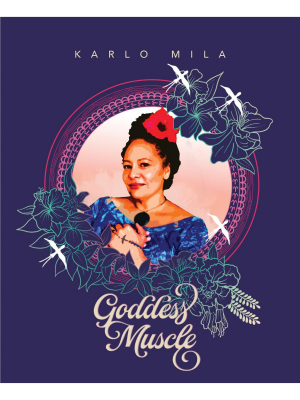Goddess Muscle

The Goddess Muscle by Karlo Mila
Huia Pub (2020)
RRP: $35. Pb, 220pp.
ISBN: 9781775504009
Reviewed by Sarah Maindonald.
Malo e lelei, talofa
Tau kē! e whaea, he mihi nunui ki a koe i tēnei mahi whakahirahira,i tēnei koha, i tēnei taonga.
‘Breathe
myself home’ (Goddess Muscle Meditation, p. 208)
As a fellow Pasifika poet, who is also of Asian ancestry and has a deep appreciation of Te Ao Māori, this collection indeed allows me to ‘breathe myself home’.
Karlo Mila’s The Goddess Muscle is a wondrous collection, an alchemy of ‘molecular lovemaking’ joining our beginnings and our endings in a uniquely framed Pasifika/ Aotearoa lens. We are taken on a journey across the Pacific where Mila begins her collection as one might begin a whaikōrero, giving a mihi to our dead poets and other significant members of our communities.
She places her work in a continuum of a community of writers, bringing them alive as they populate her pages. We travel up rivers with her to meet them, standing in awe of their failings, their journeys, seeing them through a less ordinary lens. Hone Tuwhare, J.C Sturm are revisited, even James K by proxy. In this way Mila re-educates us, reintroduces us. To Jacqui, J.C, Te Kare Papuni, for example, she allows us to find such timeless lines written in the 1940s:
And white must cease to trample underfoot
These dark leaves of the Polynesian tree
(J.C.Sturm, Brown Optimism) acknowledging the pioneer poets who came before her
The Goddess Muscle of Papatuanuku flexes and fails as she is celebrated and yet endures our careless occupation.
Malaga touched me as it encapsulates the journey of the spirit at point of death to Te Rerenga Wairua, the leaping off back to the islands, Savaii, Futuna, Uvea, Tongatapu to the cleansing waters of Falealupo. This is dedicated to Alice Suisana Hunt.
The Goddess Muscle is full of movement, colour, sensuality, death, wayfaring. It’s a celebration of life. She is the quintessential New Zealand poet. No longer are we just men alone but women in community with our ancestors. We trace the warp and weft of her weaving together in a journey that takes us to ‘the stardust in our bones’.
She dances with form and colour, complimented by the beauty of the proudly Pacific artistry which adorn the collection. Her poems stamp themselves with mana across rainbow pages, both collective and individual, local and universal:
‘I am lonely.’
This line, for example, stands alone in the middle of the page, and a river washes in diagonal drifts across the page form reflecting meaning with punch.
We are engaged in a pleasurable immersion, familiar and unfamiliar. Mila embodies science, an ‘alchemy of soft anxieties’, she acknowledges the indigenous knowledge of tangata whenua and connects cousins across Te Moana nui a Kiwa. Her writing is soulful, torrid and transcendent as we tumble in the darkness of Te Kore and whorl into Te Ao Marama.
Not often are we invited to this kind of literary hākari.
Ngā mihi, ngā mihi, ngā mihi.